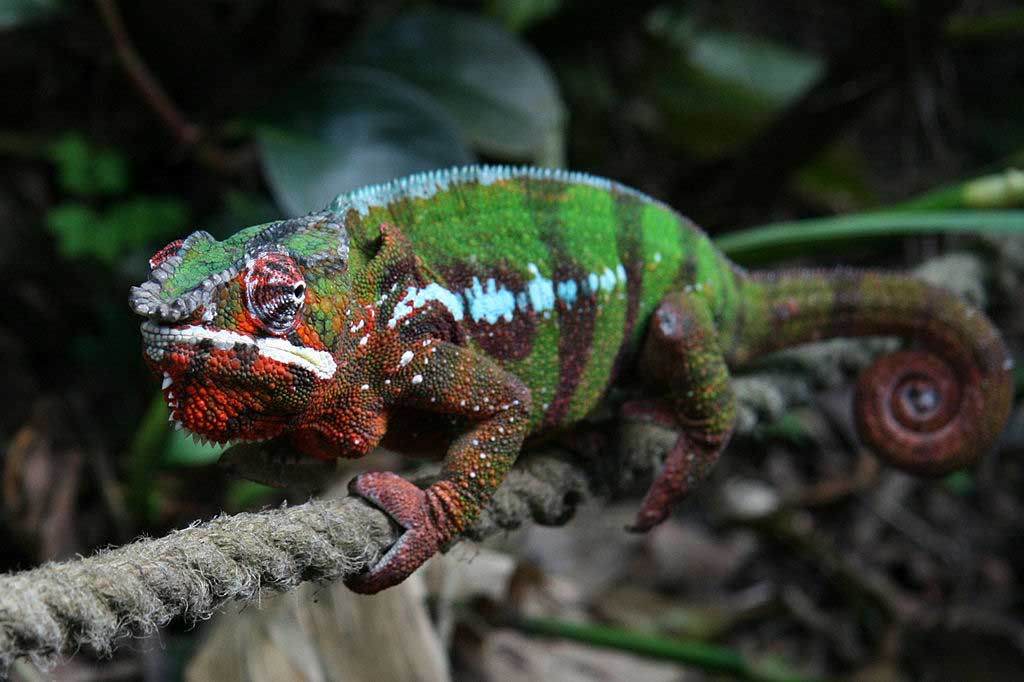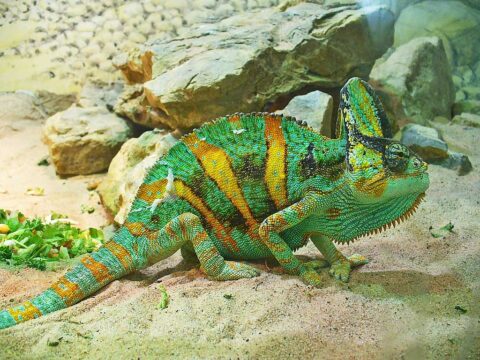
Content |
|---|
Origin / Distribution
The Chamaeleo calyptratus (Veiled chameleon) is a lizard native to Yemen and southern Saudi Arabia. There are local variants with different colors.
Characteristics / Appearance
Depending on local origin, the males reach a length of 35 to 60 centimeters, the females of 20 to 45 centimeters. Adults have a hoof-shaped parital crest on their head, which is flattened on the side and heads backwards. This helmet is not only much larger in males, up to eight centimeters in height, but also much more striking than that of females. They also develop a characteristic calcaneal spur on the heels of the hind legs., which may be seen as a bump in young males shortly after hatching.
In the course of growth, a thickening of the tail area in the cloaca is added. The coloration of both sexes depends mainly on mood and varies greatly. The color spectrum of your (i)chromatophores includes green, the brown, the blue, the target, the black, yellow and orange, as well as many intermediate tones. The basic coloration of males is usually dominated by green tones. On the flanks there are usually three, rarely four or five, vertical stripes, wide and yellow, often with fine brown edges, to which darker horizontal spots may be attached (brown). Females usually show paler shades between green and brown, often with irregular yellow spots. The structure of the body, especially typical eye adaptations, the language, tail and legs, correspond to the typical structure of the Chamaeleonidae.
Habitat
The species inhabits an extensive and climatically heterogeneous range in the south of the Arabian Peninsula. In this area several local forms have evolved that differ significantly in color and size, and those living in the north outnumber those in the south in size and color. Some of them inhabit very different habitats.. They are found both on the dry plateaus and poor in vegetation of Yemen and Saudi Arabia as on the slopes of the vegetation-rich mountains of southern Yemen. Even in the tropical to subtropical climate of the province of Seize, that belongs to Saudi Arabia and, with an annual rainfall of 2000 Mm, It is the wettest and most vegetated area of the Arabian Peninsula, There are Chameleons from Yemen, represented here by the subspecies Chamaeleo calyptratus calcalifer.
Behavior

Males are the typical loners who defend their territory against any other male. During conflicts they show a typical threat pattern. Animals flatten their body and inflate the throat pouch. Nod their heads, make wheezing sounds when they have their mouths open and wag their tail in and out. The body slowly swings back and forth, revealing the most garish colors. If this display behavior does not have the desired effect, can lead to fights in which animals can be seriously injured. This occurs especially when the lower male lacks the possibility of retreating.. Males as young as four months old behave aggressively toward each other. Females are more compatible with each other.
Diet
Like all chameleons, the Veiled chameleon feeds mainly on small animals. Mainly, “Shoot” to a wide variety of insects with its tongue. But, nor do they disdain vertebrates to the size of half-grown mice. In addition to food of animal origin, plant foods are ingested, especially in the form of succulent leaves, such as those of various species of Kalanchoe. This plant food serves, among other things, to complement the water balance, and water, whether it is available in mostly steppe habitats, also drunk. It usually licks the leaves in the form of dew. In the first months, the Chameleons of Yemen need a lot of food, as they grow very fast during this period. In some cases, four-month-old males can reach a length of 30 centimeters.
Reproduction
When a male meets a female, flattens your body to the maximum, swings back and forth, rolls its tail rhythmically up and down and displays a magnificent mating show. If the female is not ready to mate, becomes intensely dark and threatens the male with his mouth open. If the male does not retreat, can be seriously injured by the female, although it does not defend itself because it is blocked by a kind of bite inhibition. In the wild, the female is ready to mate once a year. It is then recognized by a turquoise blue coloration in the upper back. The male who courts chases the female who is willing to mate, giving him violent blows on the flank. Mating, which is repeated several times a day, hard between 10 and 30 minutes and usually takes place over a period of three to four days, in exceptional cases even two weeks.
The female indicates subsequent pregnancy with yellow and turquoise blue spots on a dark green background, almost black. After an average period of 20 to 30 days, in exceptions up to 50 days, the female digs a tunnel-shaped burrow, at the end of which the eggs are laid, an average of 30 to 40 (maximum up to 100), of about 15 millimeters long and 10 millimeters wide. Then, this burrow closes. Depending on the temperature (of 20 to 30 degrees Celsius), the offspring of 55 to 75 millimeters in length hatch after five to nine months. At a constant temperature of 28 degrees Celsius, males and females hatch after about six months, while at an incubation temperature consistently higher than 30 degrees Celsius, almost only males hatch. This is obviously a temperature-dependent sex formation.. It also, young animals appear to coordinate or synchronize their hatching, since normally all animals of a clutch are born on the same day. Split but incubated clutches in the same conditions are usually born on completely different days.
Threats to the species
The Veiled chameleon has the protected status of the Washington Convention on the Protection of Species II, Appendix B and, therefore, is notifiable to the owner of the terrarium at the time of acquisition.
The "Veiled chameleon" in captivity
The Yemeni chameleons can become very confident and meek.
The terrarium
The Veiled chameleon it is kept in a high terrarium with very large ventilation areas. These animals must be kept individually. The terrarium must have at least 130 x 60 x 180cm. Higher would be better. Animals need a lot of fresh air, but without drafts.

In the terrarium of a Veiled chameleon there must be many possibilities to climb, preferably a tree (Ficus benjamina), remained, other plants, cork and bark tubes, that also offer places to hide.
Temperature and lighting
The temperature in the terrarium should be 28-32°C during the day (locally, about 40°C) and between 18-22°C at night. The humidity should be 50-60% and around the 80% At night.
For your well-being, good lighting and ultraviolet light are necessary (30% of UVA rays and 5-10% UVB), as well as a place to sunbathe. UV radiation is very important and necessary. In the case of females, a suitable place for egg laying must be provided.
A spray system can be installed in the terrarium, spraying some water in the morning and evening. For fluid intake, a dropper must be installed, that is always cleaned.
Food
The diet of the Veiled chameleon consists mainly of insects such as crickets, crickets, grasshopper, flies, fruit flies, cockroaches, and rarely wax moth caterpillars – but be careful when feeding! Animals gain weight easily and can develop gout. It is convenient to supplement your diet with fruit.
no lettuce, iceberg lettuce or similar, since its calcium-phosphorus content is unfavorable. And cabbage or spinach should rarely serve as food for them by oxalic acid.….
Additional vitamin and mineral supplements are recommended.
Reproduction
Adult chameleons are only given animal food every two to three days. This can prevent females from laying eggs too often or even having difficulty laying eggs due to the development of unfertilized eggs. . Females can often be kept together in spacious terrariums. Keeping them in pairs is rarely permanent and should only be tried when females have reached the age of one year to avoid premature pregnancy.. Pregnant females should be separated from males and moved to a terrarium with a slightly moist substrate of at least 30 centimeters deep.
Hibernation
You have to let the Veiled chameleon hiberne for two or three months. Animals need a temperature of 20-25°C. Hibernation is very important for animals to regulate their bodily functions and stay healthy.
Buy one "Veiled chameleon"
The price of a "Veiled chameleon" in the exotic animal market ranges from 70 – 120 EUR.
Videos "Veiled chameleon"
|
|
|
|---|
Alternative names:
1. Veiled chameleon, Cone-head chameleon, Yemen chameleon (English).
2. Caméléon casqué, Caméléon casqué du Yémen (French).
3. Jemenchamäleon (German).
4. Camaleão do Iêmen, Camaleão velado (Portuguese).
5. "Camaleón de Yemen", Camaleón velado (español).